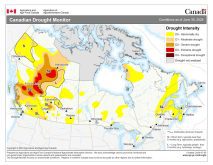Recommendations are now being crafted for Agriculture Minister Marie-Claude Bibeau on how to improve business risk management (BRM) programs for farmers in Canada.
It’s expected changes to BRM programs will be announced in July when Bibeau and her provincial counterparts meet in Guelph.
The recommendations are coming after a study by MPs on the Commons standing committee on agriculture and agri-food was conducted, featuring stakeholders from within the ag industry and government.
Tom Rosser, an assistant deputy minister at Agriculture and Agri-Food Canada (AAFC), said the government is looking at a number of options to improve the programs, which are often the focus of complaints from producer groups.
Read Also

Prairie forecast: Northwest flow ushers in a wintery pattern across the Prairies
Manitoba and Saskatchewan can expect cold temperatures to settle in. Alberta will benefit from some moderating influences, with colder temperatures not expected to last long.
“We have heard a number of ideas from producers. In addition, we are having proactive discussions with the provinces to understand their perspective on these issues and to come to a consensus on reforms. We are considering a number of options,” he recently told the ag committee.
The current iteration of risk management support began in 2003 when provinces and the federal government agreed to standardize supports in a cost-shared policy framework.
Although originally the programs were focused on income stabilization, provincial and federal governments realized they were covering “what would be considered normal business risks in many cases,” according to Paul Samson, an AAFC assistant deputy minister.
Consecutive years of strong commodity prices also followed, resulting in higher levels of profitability and justification for governments to allocate funding away from risk management towards other areas, such as innovation and growth.
The current agreement between federal and provincial governments was signed in 2017 and carried forward five programs aimed at BRM: AgriStability, AgriInvest, AgriInsurance, AgriRecovery and AgriRisk.
Canadian Federation of Agriculture vice-president Chris van den Heuvel said Canadian producers, when faced with risks beyond their control such as trade disputes and rail disruptions, are left at a “distinct competitive disadvantage” in comparison to the government supports available to farmers in the U.S. and European Union.
“The current BRM suite, which was created to help farmers manage risks beyond their control, is failing farmers as these risks increase and program coverage does not keep pace,” he told the ag committee at its meeting Tuesday.
Minor changes to AgriStability, made in December when Bibeau last met with her provincial counterparts, “are modest in nature and fail to address the primary concerns voiced by Canadian farmers,” he said.
Those changes agreed upon were meant to incentivize farmers to seek out more private insurance to “top up” their coverage beyond what the federal government offers.
The government at the time also launched a pilot program aimed at reducing concerns over the administrative burden involved in applying for BRM programs.
More details of those changes aren’t yet available, but government officials are cautiously optimistic they will help improve enrolment in AgriStability.
In 2016, only 31 per cent of eligible producers, representing about 56 per cent of market revenues, enrolled in the program.
AgriStability, which is meant to provide support to farmers against large declines in farm income, has long been the focus of most complaints regarding the suite of BRM programs.
Beyond concerns of cumbersome paperwork, producers argue reference margins should be lifted from the current 70 per cent to the pre-2013 level of 85 per cent.
“In terms of the cap, the limit, the reference margin, I can confirm that it’s something we are looking at with our provincial and territorial colleagues,” Samson told the committee. “These discussions will continue over the next few months.”
BRM programs are funded by federal and provincial governments, at a cost share ratio of 60:40. The cost has averaged roughly $1.5 billion in the past five years.
Changes to any BRM programs generally require two-thirds of the provinces representing at least 50 per cent of the market, according to federal officials.
While the committee’s report will be delivered to Bibeau and could inform her meetings with the provincial ministers in July, the release of the federal budget on March 30 could signal whether the federal government is prepared to increase funding to BRM programs this year.
— D.C. Fraser reports for Glacier FarmMedia from Ottawa.














